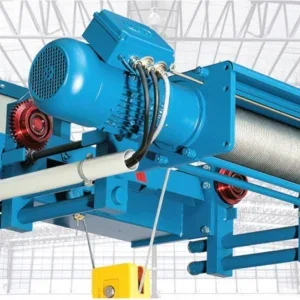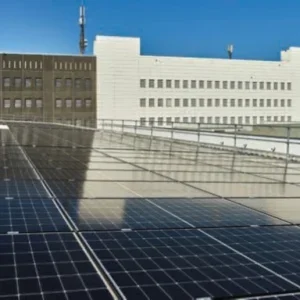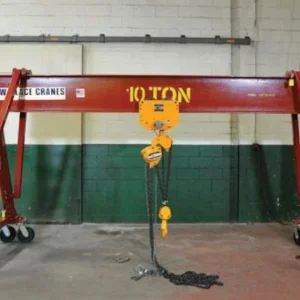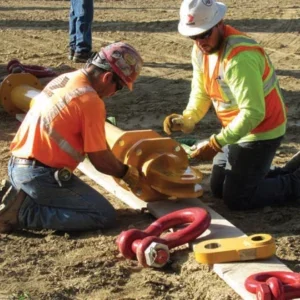A new show in London’s West End this summer brought to the stage a re-working of the 1987 film The Witches of Eastwick, itself based on a John Updike novel. Key to the success of the show was making the witches fly realistically. It is easy on film – trick photography can create any illusion. On stage it is a little harder. Yet the technicians pulled it off triumphantly, according to the critic from The Times newspaper who reported: “Since their wires are all but invisible, and jet-powered broomsticks are entirely absent, the witches of Eastwick seem literally to be riding on nothing.” Special effects like the ones used in this show often rely on some kind of hoisting equipment. Automation and winching systems in the entertainment industry are increasingly important in modern productions. Powered systems, for example, are replacing the traditionally manual process of ‘flying’ people and objects on stage.
Powered flying is safer because there are no heavy counterweight systems to load and unload, and control can be done from a chosen vantage point where there is good visibility. More complicated effects can be produced with a powered system – in two dimensions – but sophisticated curved movements of an object in three dimensions were not possible until the development of a new control system, pioneered in The Witches of Eastwick.
Computerised hoist control is not new, but for three dimensional movement, with a difference, a UK company has a new product, aimed at the entertainment industry, but perhaps also with potential for industrial application.
The system allows objects such as people and scenery to be ‘flown’ in three dimensions, along a precisely repeatable programmed path, suspended from cable hoists. Stage Technologies, which designed and developed the system, is a specialist stage automation and power flying company based in London.
The idea for the Pathway system came out of a Stage Technologies project late last year at the Millennium Dome in London using the company’s Acrobat control and hoists. That project included two-dimensional flying sets and software for 12 performers – a total of 24 hoists. Performers were to be moved in straight lines and simple arcs but with so much space available in the Dome, the question was raised whether the system could be expanded to work with three or more hoists, to control the third dimension.
First application for the Pathway computerised multi-axis hoist automation system for the entertainment industry was The Witches of Eastwick which opened on 18 July at London’s Theatre Royal, Drury Lane. Three of the main characters are simultaneously made to ‘fly’ along different pre-programmed paths by synchronising sets of three wire rope hoists attached to each performer. Complicated curved trajectories can be created and speed of movement can also be varied through the sequence. Alterations can be made to the routine by reprogramming the control software.
Having specified start and stop positions for the object, its intended path is plotted between these points using X, Y and Z co-ordinates. The path can be graphically manipulated, and simulated and viewed on screen from different angles. No mathematical calculations have to be made by the operator as they are all ‘buried’ in the software. The path is converted into cable lengths for each of the hoists and the Stage Technologies Maxis hoist control software synchronises movement between them. An unlimited number of path designs per object is claimed and as many as eight object paths can be run at any one time.
The object’s speed as it follows the path can be set in units, for example to run at X number of mm/s, or the speed can be programmed by linking the path to a velocity profile. In addition, speed can also be varied by an operator at any point during the move using the company’s Acrobat controller, without having to stop the motion.
Hoists are fully synchronised and millimetre accuracy and repeatability is claimed. As many as 32 hoists can be attached to each object and they can be positioned sufficiently remotely to be out of the audience’s sight. This is an advantage over the original concept for The Witches of Eastwick stage show, for example, which would have had tracks suspended from the roof of the auditorium. These tracks would have detracted from the spectacle by being visible to the audience. A second disadvantage was that the only way to alter the direction of the path would be by having to physically move the tracks.
Mechanical components
On the mechanical side, Stage Technologies has a range of winches designed and built in-house called Big Tow. Capacities range from 125kg to 1,100kg. The universal cable winch is claimed to have zero fleet angle, a near-silent motor and to be compact and light enough for easy transport. Mounting is not restricted to underneath a stage or in a separate soundproof room.
The patented zero-fleet design is to ensure that the cable’s take off point from the winch drum does not change, so the mounting position is not dictated by fleet angle. It is achieved by using a design that allows the winch drum to move along the frame, thereby maintaining a constant take off point.
Virtually silent running is said to be possible from the brushless servo motor design when it is used with Stage Technologies’ Maxis high frequency servo drive system. The servo motor has a built in position sensor which gives incremental encoder positioning to the position control system.
A brake is also built in to the motor and a second brake, spring applied and electrically released, can be fitted to the winch on the output side of the gearbox.
The Big Tow 200 series needs a mounting height of 200mm and all three series can be mounted in any orientation or plane and the cable take off can be at any angle as long as it is at 90° to the drum axis. Common applications include its use as a point hoist, multi-line winch or deck winch. Connectors are standard for power and control functions to simplify installation and fault finding, and limit switches are adjusted by strikers.
Standard Big Tow models are available in three frame sizes but custom built units are also possible. The three models in the Big Tow 200 series have maximum capacities of 125kg, 250kg and 325kg, in the Big Tow 290 series capacities of 300kg, 400kg and 500kg, and 650kg, 850kg and 1100kg in the Big Tow 350.
Maximum line speed is between 1,000mm/s and 2,000mm/s, minimum line speed is 0.5mm/s and position accuracy is to within 1mm using the Maxis drive. Drum capacities with a single line allow between 40m and 100m of travel.






